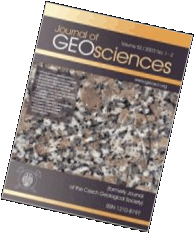 Export to Mendeley
Export to MendeleyMore articles on Evolved felsic igneous systems and granitic pegmatites
Original paper
Chemical and spectroscopic characterization of tourmalines from the Mata Azul pegmatitic field, Central Brazil
Journal of Geosciences, volume 63 (2018), issue 2, 155 - 165
DOI: http://doi.org/10.3190/jgeosci.258
This study characterizes natural black, blue, dark green, light green and pink tourmalines from granitic pegmatites of the Mata Azul Pegmatitic Field in central Brazil. The differences were assessed by applying electron-microprobe analysis as well as Mössbauer and optical spectroscopies. Mineral chemistry data show an increasing Mn/(Mn + Fe) atomic ratio as follows: black (0.01-0.02), blue (0.04-0.05), dark green (0.09-0.21), light green (0.33-0.42) and pink (0.68-1.00).
The Mössbauer spectroscopy results show the presence of Fe2+ (doublets with isomer shift (δ): 1.04-1.15 mm/s) for the black, blue, light green and dark green tourmalines. Fe2+ is found in three different environments that are identified by quadrupole splitting (Δ) of 2.38-2.49 mm/s for the first, Δ = 2.13-2.34 mm/s for the second, and Δ = 1.54-1.71 mm/s for the third. The black sample spectrum has an additional fourth doublet (δ = 0.78 mm/s, Δ = 1.22 mm/s) that is assigned to an electron delocalization between Fe2+ and Fe3+.
In the studied samples, the black color results most likely from high absorbance in all the visible spectra caused by Fe2+-Fe3+ intervalence charge transfer (IVCT) (780 nm), Fe2+ d-d transitions (730 nm, 670 nm), Fe2+-Ti4+ IVCT (430 nm) and transitions related to Mn cations (550 nm). Blue is differentiated from green colors by a higher absorbance in the 730 nm region (Fe2+ d-d transitions), and a higher FeO content, as well as a lower absorbance in the 430 nm region and a lower TiO2 content. The green colors are associated with the absorption bands at 730 nm (Fe2+ d-d transitions) and 430 nm (Fe2+-Ti4+ IVCT). The light green color exhibited a lower intensity of these bands compared to that of the dark green color, and an additional band at 320 nm (Mn2+-Ti4+ IVCT). The pink color results from the high degree of Mn-Fe fractionation but it was not possible to assure the oxidation states of the Mn cations.
Webdesign inspired by aTeo. Hosted at the server of the Institute of Petrology and Structural Geology, Charles University, Prague.
ISSN: 1803-1943 (online), 1802-6222 (print)
email: jgeosci(at)jgeosci.org


IF (WoS, 2024): 1.3
5 YEAR IF (WoS, 2024): 1.4
Policy: Open Access
ISSN: 1802-6222
E-ISSN: 1803-1943